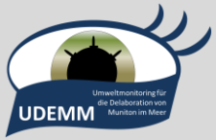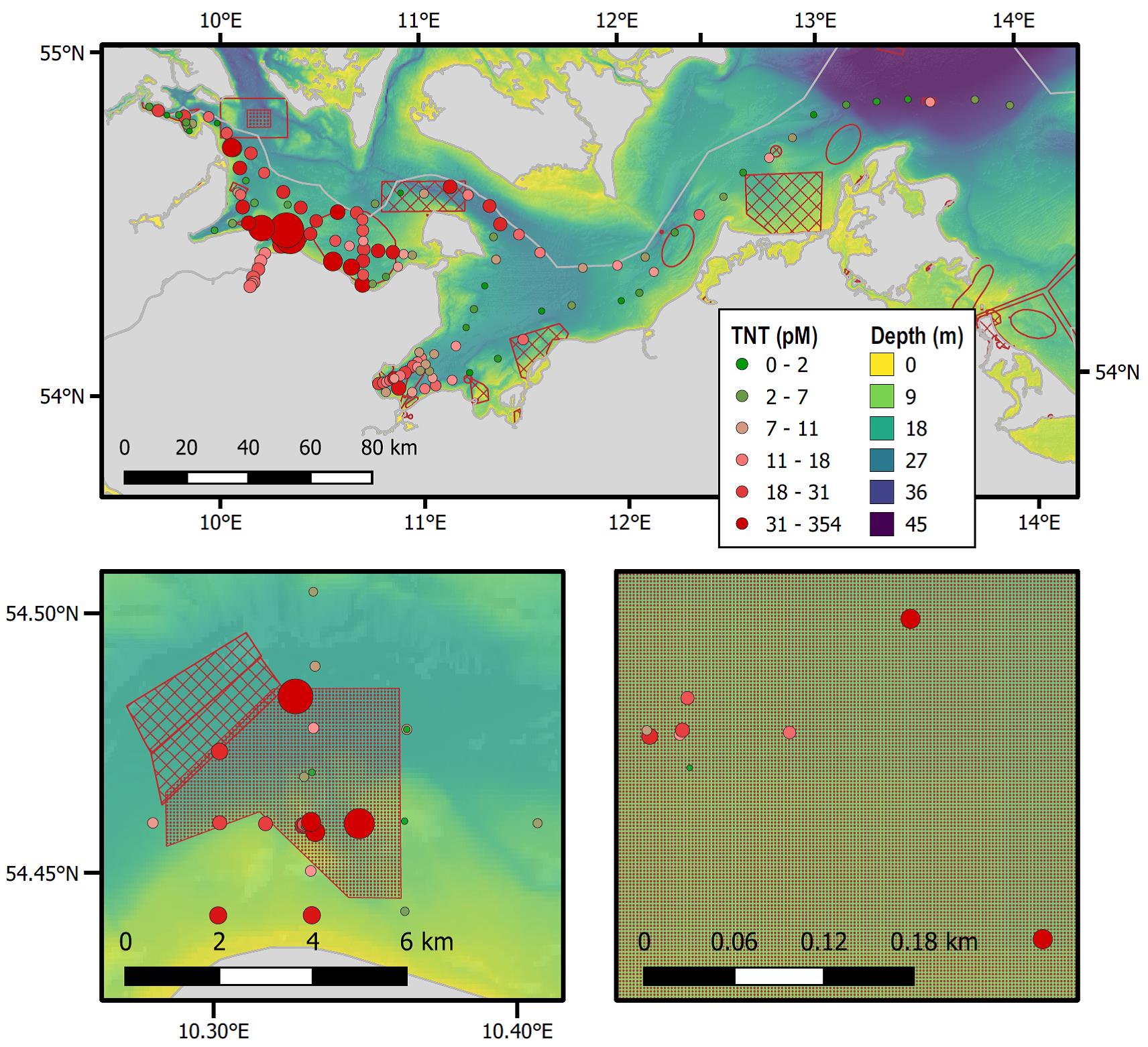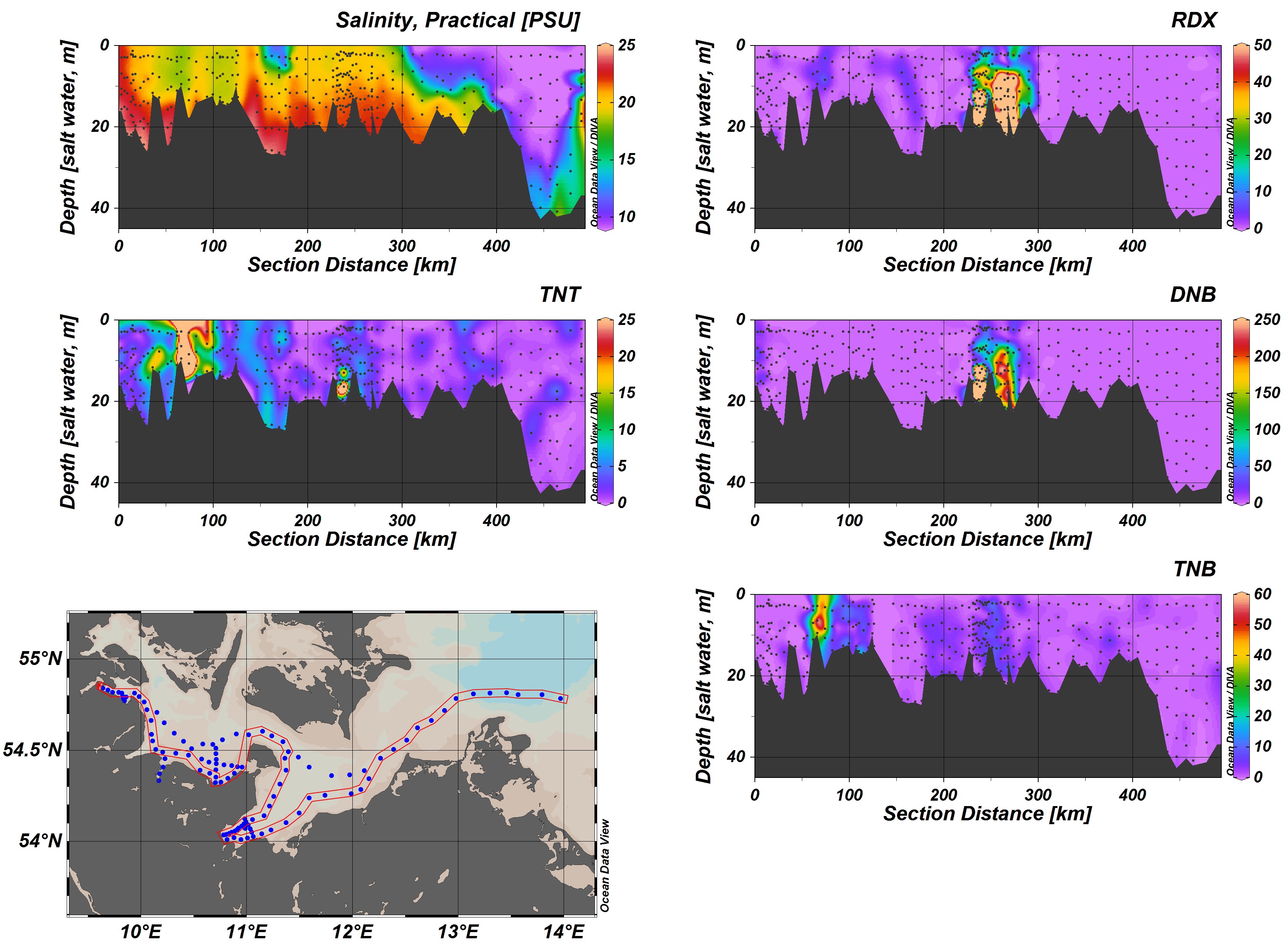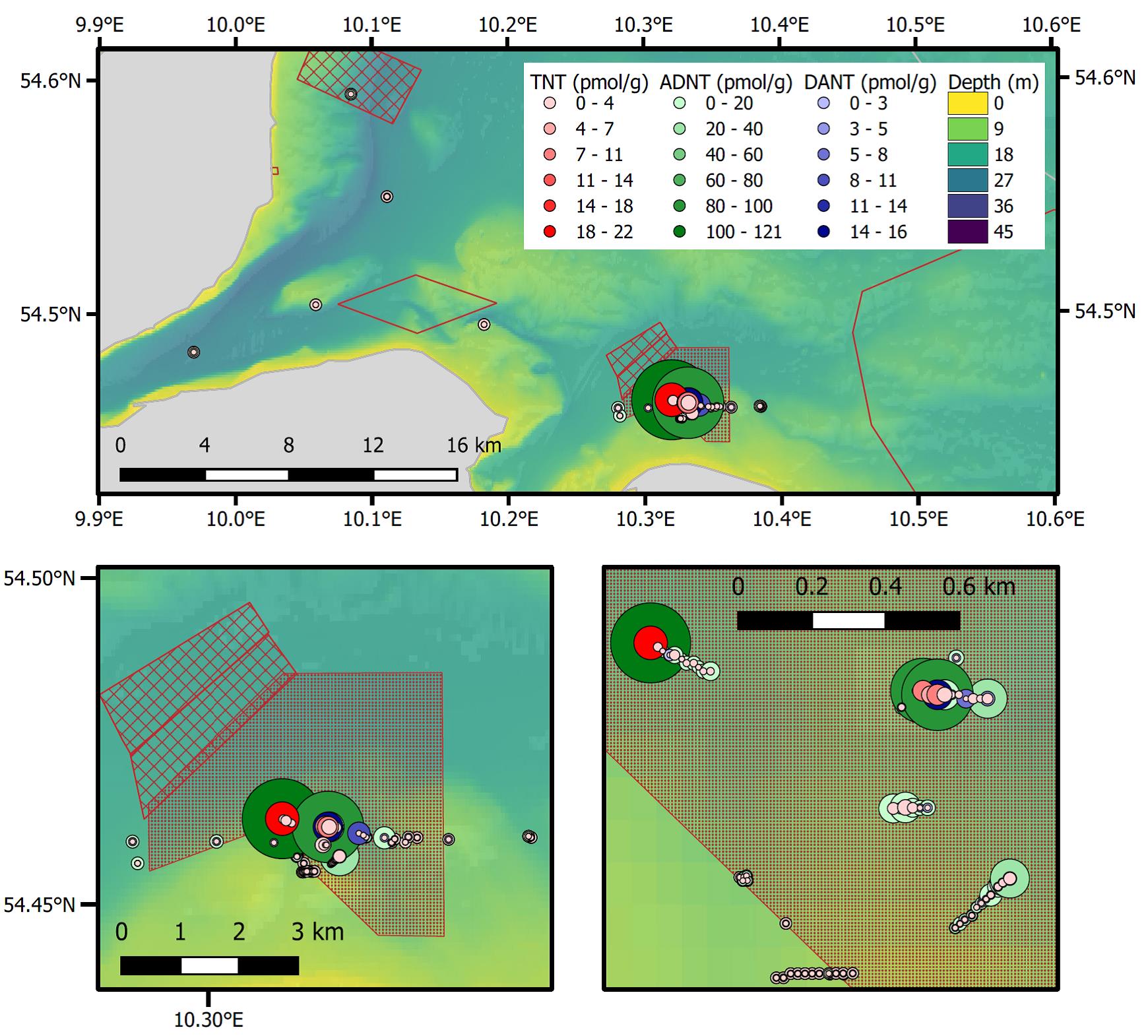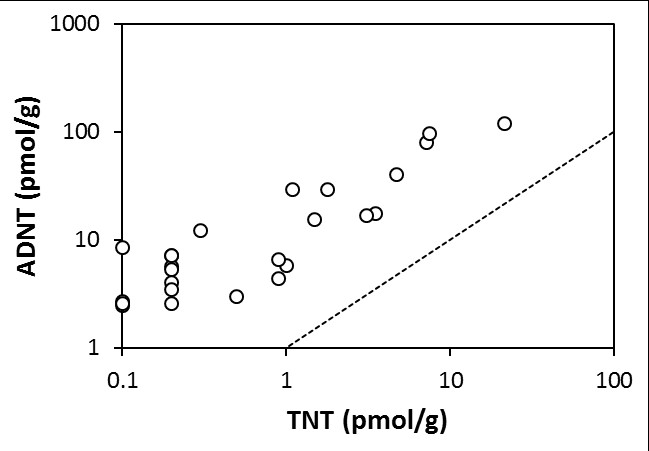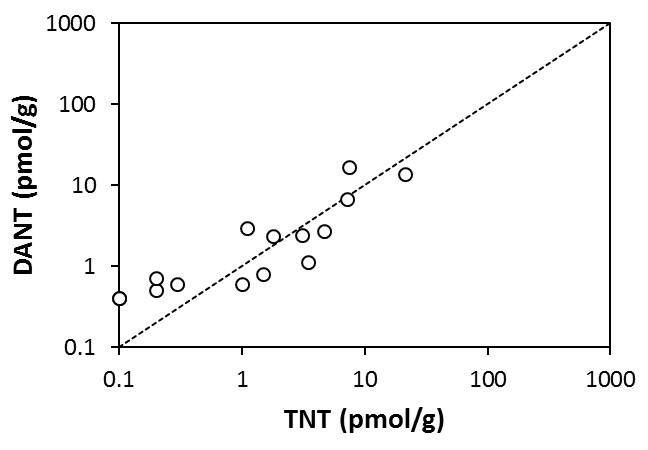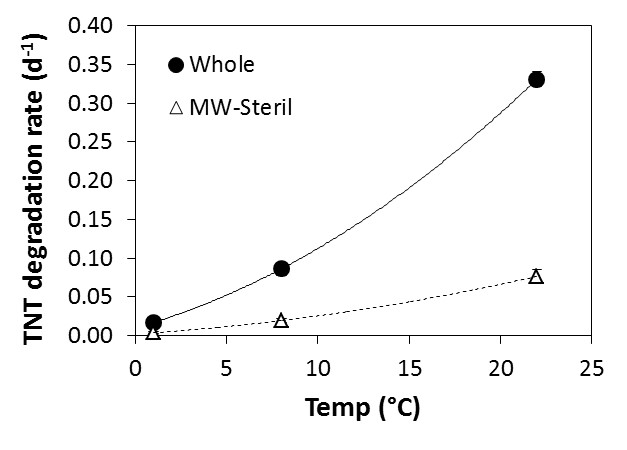WP3: Geochemical investigations into the dissemination of contaminants in conventional ammunition
GEOMAR Helmholtz Center for Ocean Research Kiel
The aim of WP3 is to investigate the release and distribution of organic and inorganic contaminants in seawater and sediments before, during and after the delaboration process. In addition, the degradation and degradation processes of these contaminants in contact with the seawater in the Baltic Sea are examined in laboratory experiments. The most hazardous organic and inorganic compounds of conventional ammunition are Trinitrotoluene (TNT) and its degradation products (Trinitrobenzene (TNB), amino-dinitrotoluene (ADNT)) as well as mercury (Hg), methyl mercury (MeHg) and lead (Pb), which were used in trigger units and explosive capsules (Pichtel, 2012). These substances can be released into the seawater and the surrounding sediment either due to the corrosion of the metal housings of the weapons or during the planned delaboration in the course of the RoBEMM project and ultimately incorporated by marine organisms. However, the biogeochemical cycles of these contaminants close to munition dump sites is yet not very well understood.
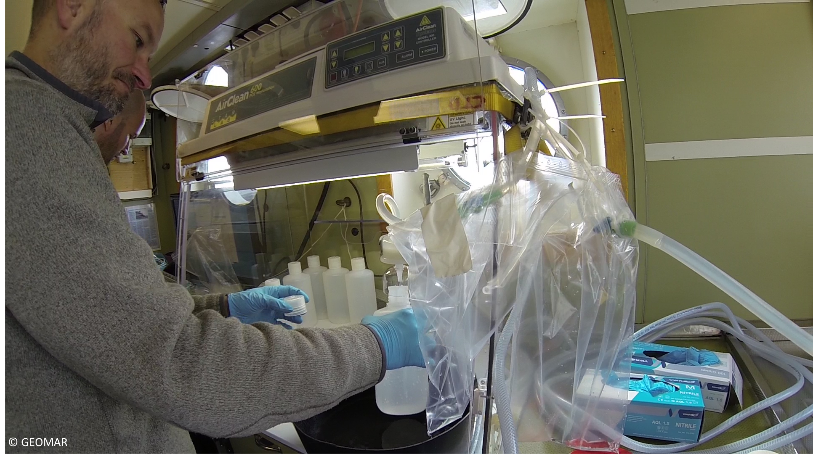
Aims and Approach
Method development: The initial project period was dedicated to the development of an analytical method with sufficient sensitivity and selectivity to detect and quantify STVs at the very low concentrations present in seawater. The outcome was a method (Gledhill et al., 2019) that allows detection of 17 STVs (both primary explosive compounds as well as their transformation and degradation products) with exceptionally low detection limits on the order of pg/L (10-15 g/L). The method relies on solid-phase extraction (using a polystyrene divinylbenzene resin), followed with coumpound separation by ultra high performance liquid chromatography (HPLC; ThermoFisher Ultimate3000) and quantification by electrospray ionization mass spectrometry (ESI-MS; ThermoFisher QExactive Orbitrap). This method is similar in principle to the automated method for munition metal analysis, which relies on preconcentration using an immobilized carboxymethylated pentaethylenehexamine resin followed by quantification by high resolution inductively-coupled plasma mass spectrometry (HR-ICP-MS; ThermoFisher ElementXR). The similarity and reliability of these preconcentration methods makes them ideal solutions to the challenge of detecting STVs during routine monitoring or during delaboration activities.
Water and sediment sampling: Water samples were collected during 12 cruises. Samples were exclusively collected using FK Littorina, except for POS530 (FS Poseidon). Initially, samples were collected with a specialized metal-free pump to avoid contamination of trace levels. After the first three major cruises, it was clear that concentrations of the target metals at the munitions dumpsite were not elevated relative to levels typical for the Baltic Sea. We also determined that pump sampling gave inadequate location precision for targeting the highly localized munition sources. As a result, metals sampling was thereafter neglected in exchage for use of a non-metal clean Kranzwasserschöpfer that allowed rapid and highly precise multi-depth sampling. Sediment samples collected by divers for grain-size analysis were split and preserved for STV analysis. During the second half of the UDEMM project period, CAU Forschungstauchern also recovered a number of biota samples for STV analysis, including macroalgae aggregates with associated faunal communities, Seesterne, and mussels. Biota (clams, polychaete worms, crustaceans) were also collected from sediments sampled during an associated project funded through the CAU Future Ocean cluster. Lastly, we also developed and constructed a hand-held sampling device for collection of high-spatial resolution samples at munition surfaces. Samples collected by CAU Forschungstauchern using this device revealed some of the highest STV concentrations measured during UDEMM, as well as data that could be used to make novel estimates of in situ explosive dissolution rates at Kolberger Heide (Beck et al., 2019).
Laboratory experiments: A number of laboratory experiments were conducted to evaluate processes affecting the release and removal of STVs. In collaboration with ROBEMM partner Fraunhofer ICT (Drs. Armin Kessler and Paul Müller), we performed laboratory experiments on the dissolution rate of explosives collected at Kolberger Heide. These experiments investigated the effects of salinity, temperature, and dissolved organic matter on dissolution rate and STV solubility. Dissolution experiments were conducted at realistic water mixing speeds, following the conclusions of our in situ investigations that indicated previous laboratory experiments were not applicable to the marine environment. Additional experiments in the shore-based laboratory as well as at sea measured abiotic and biotic (microbial/bacterial) controls on degradation of STVs at environmentally-relevant concentrations. Degradation experiments were also used to follow the production of TNT daughter compounds such as amino-dinitrotoluene and diamino-nitrotoluene. The results of our dissolution and degradation experiments form the basis for source-sink parameters implemented in the oceanographic model developed in AP2. Lastly, microbial community analyses of water, sediment, and munition biofilm indicated a diverse microbial population that at first approximation differed among munitions-contaminated and control sites.
Results
Dissolved munitions compounds in the water column
Dissolved munition compounds (MC) were detectible in nearly all water column samples collected during the UDEMM project. Concentrations showed a range exceeding nearly nine orders-of-magnitude, most likely due to rapid mixing and dilution. Most of the samples showed TNT concentrations on the order of 1-10 pM, highlighting the critical need to use ultra-sensitive detection methods such as those developed during UDEMM. Previous results showed that STV distributions in the water column were highly variable in both space and time, and that high resolution sampling is required to adequately monitor the regional magnitude and extent of contaminant plumes from underwater munition dumpsites. As a result, the sample collection and processing method developed earlier during UDEMM (and published in Gledhill et al., 2019) were modified to reduce processing time and facilitate higher frequency sampling.
Dissolved munitions compounds at the regional scale
At the regional scale (Figure 1), clear gradients were evident in TNT concentration. Areas with munitions dumpsites (e.g., Kolberger Heide; Lübeck Bight) or known munitions contamination tended to show the highest concentrations (up to 354 pM for TNT). Nonetheless, there were marked differences among dumpsites, illustrated by the nearly order-of-magnitude difference between maximum concentrations observed in Oct 2018 in Kolberger Heide (354 pM) compared with Lübeck Bight (43 pM). This, despite estimates that Lübeck Bight contains about double the amount present in Kolberger Heide (Böttcher et al., 2010). TNT concentrations were lowest in the Arkona Basin and the Mecklenburger Bight, likely as a result of their deeper water column and greater distance from munitions sites. Water exchange through the central channel and Belt Sea (north and northeast of Fehmarn) dilutes contamination originating close to coastlines, although samples collected north and northeast of Fehmarn showed substantial TNT enrichment.
|
|
| Fig. 1: a) Regional-scale distribution of dissolved TNT in bottom waters throughout the southwest German Baltic Sea. b) Wide-local scale of dissolved TNT in bottom waters at Kolberger Heide. c) Narrow-local scale view of the cluster of overlapping points at center in 2b. d) Feature-scale gradients within 1 m of munition surfaces. Symbol color and size (in a-c) indicate concentration. Shading in (d) distinguishes among 17 individual sample sets. Data shown in (a-c) includes samples collected in October 2017 and 2018. Data in (d) are redrawn from Beck et al. (2019) and include March, June, and October 2017. Additional data in (d) are from October 2018. Note that the units in (d) are on a log-scale and are 1000-fold higher than in (a-c). |
The widespread presence of munitions on the Baltic seafloor make it challenging to link specific MC sources to plumes of dissolved MCs in the water column. Elevated concentrations oberved in the far western basin, and the wide dispersion of MC on local scales (Figure 2) imply long-range transport of MCs. This must occur on relatively short time scales, before loss by microbial or abiotic degradation or sorption and sedimentation with particles.
|
|
| Fig. 2: Sections showing the regional MC distribution with depth along the nearshore cruise track of POS530 highlighted in red (October 2018). The Kolberger Heide (located at ~75 km) and the Lübecker Bucht (at ~250 km) are particular focal points of the STV load. Black dots show the positions of the individual samples used for contouring. TNT = Trinitrotoluene, RDX = Hexogen, DNB = Dinitrobenzene, TNB = Trinitrobenzene. |
Loss of MC through mechanisms such as degradation or sorption is likely to depend on site-specific characteristics such as temperature and salinity. Evaluating the impact of MC release on ecological systems requires constraint of potential long-range transport and chemical residence times. A number of simple experiments were conducted during UDEMM (see below) to provide an approximation of these controls and a quantitative constraint for modeling purposes.
Dissolved munitions compounds on the local scale
On the local scale (0.05 – 5 km) in Kolberger Heide, water column TNT distributions show some indication of gradients around known munitions hotspots (Figure 2 and Figure 3). A general east-west increase in concentration cross the entire Kolberger Heide site may reflect enrichment of water traveling along the predominant current direction (Figure 2). However, on the small local scale (10s to 100s of meters), gradients seem to be smoothed out by water mixing. For example, nine samples collected within 200m around a pile of some 70-90 sea mines show no clear gradient in dissolved TNT (Figure 3). This suggests that on such spatial scales, mixing is rapid relative to both input from the munition source as well as removal mechanisms such as degradation.
|
|
| Fig. 3: Mass ratio of RDX and DNB to TNT observed in three in situ benthic chamber incubations of different explosive solids. |
A variety of explosive compounds are present in an even more extensive array of explosive mixtures, with more than 500 formulations manufactures (Haas and Thieme, 1996). Most organic explosives also undergo degradation or transformation to daughter compounds. Many of these daughter compounds are equally or more toxic than the parent, or toxicity is unknown. Such alteration can occur on a time scale of hours to days. It may thus be possible to have high input fluxes, but low water column inventories of the parent MC. Monitoring only the parent MC would underestimate the total chemical release. This underscores the importance of multi-compound chemical analyses for evaluating chemical emission from underwater munitions.
The method developed during UDEMM (Gledhill et al., 2019) targets 17 compounds, including both a variety of explosives as well as several daughter product compounds. This was important to elucidate chemical release trends across all spatial scales.
At the regional scale, major differences were observed in the abundance of different explosive compounds. One of the most obvious difference was evident between Kolberger Heide and Lübeck Bight. Lübeck is posited to have nearly double the quantity of munitions compared with Kolberger Heide (Böttcher et al., 2010). Dissolved TNT concentrations were nonetheless eight-fold lower in Lübeck (43 vs. 354 pM). In contrast, the explosive compounds RDX and DNB were more than 30-fold higher in Lübeck compared with Kolberger Heide. This suggests a major difference in the type of explosives dumped at the two sites. Whereas TNT inventories indicate lower MC contamination in the Lübeck Bight, DNB and RDX suggest a contrary situation. Monitoring that targets only individual compounds can lead to vastly differing conclusions about the extent of explosives contamination.
At the feature scale, in situ benthic chamber incubations of individual exposed explosive solids at Kolberger Heide revealed clear compositional differences. The ratio of TNT, RDX, and DNB released from three separate solids showed order-of-magnitude differences. This suggests that there is heterogeneity in explosives dumped at individual sites as well as among different sites. Strategies to monitor the overall chemical release from underwater munitions must therefore take into account spatial variability in the explosive source types.
Sediments
Surface sediments showed similar MC patterns to the water column, although a smaller sample set was collected during UDEMM. At the regional scale, sediment MC were higher at the KH dumpsite compared with more distant sites, suggesting that sediment-associated MC are retained locally to some extent. Comparison of compounds in the TNT degradation chain (TNT -> ADNT -> DANT) showed no clear spatial gradient. ADNT and DANT were the most abundant compounds detected. Concentrations of the three compounds generally co-varied, but there were no obvious patterns in their spatial distribution.
|
|
| Figure 4: a) Regional-scale distribution of dissolved TNT in bottom waters throughout the southwest German Baltic Sea. b) Wide-local scale of dissolved TNT in bottom waters at Kolberger Heide. c) Narrow-local scale view of the main Kolberger Heide site. The cluster of points near the center is a transect across the mine mound described above. Symbol shading and size indicate concentration, and color distinguishes among the three compounds. |
|
|
| Figure 5: Covariation of (a) ADNT and (b) DANT with TNT in sediments. The dashed line indicates a 1:1 relationship. |
Local retention of sediment MC is consistent with the pattern observed at the km-scale. Elevated concentrations were observed within km of muntions hotspots identified by seafloor mapping, but declined rapidly away from the central source. In contrast, enormous heterogeneity was observed at the sub-km scale. Samples separated by 10s of meters showed as much variability as transects separated by several hundred meters.
No clear gradients were observed in feature-scale (<2 m) sediment MC distributions around four individual mines investigated in 2017. Concentrations varied from less than 1 to several hundred pmol per gram. , and maximum concentrations varied widely among mines. This is consistent with observations that munition housing corrosion varies widely among objects at the Kolberger Heide dumpsite. Similar to regionally-collected sediments, ADNT and DANT tended to exceed their parent compound TNT. The relative quantities of TNT and its amino-derivatives ADNT and DANT indicate that transformation (likely microbially-mediated) limits the persistence of TNT in sediments. This further underscores the importance of monitoring chemical residues, not only the original parent compounds. In the case of TNT and its daughter compounds, ADNT and DANT appear more stable and persistent in sediments, as also expected from their greater sorption potential (e.g., Sheremata et al., 1999). As a result, these may be the chemical forms exposed to biological receptors, consistent with ADNT accumulation observed in mussels (Appel et al., 2018; Strehse et al., 2017).
|
| Figure 6: Examples of sediment STVs (MC, munitions compounds) content in surface sediments collected radially around individual munitions. Colors indicate TNT (red), ADNT (green; a transformation product of TNT), and DANT (blue; a transformation product of ADNT). Circle sizes indicate STV content; note different scales among figures. Molar units are used to allow direct comparison of the different compound amounts. |
Sediment-associated MC levels are unlikely to respond rapidly to changes in MC release from underwater munitions. Nonetheless, they do provide a long-term view of contamination at dumpsites, particularly from a regional perspective. Heterogeneity at local and feature scales suggests that random, statistically-representative sampling is necessary to adequately establish contamination levels.
Source term – Dissolution
Dissolution of solid explosives is the foundational control on MC emission from underwater munitions. Dissolution rates are affected by physicochemical conditions such as temperature, salinity, and mixing energy, as well as explosive chemical formulation (Lynch et al., 2001; Lever et al., 2005; Monteil-Rivera et al., 2010; Dontsova et al., 2006). All else equal, MC release may therefore be highly site-specific. In UDEMM, multiple approaches were used to quantify dissolution fluxes. In situ dissolution was measured directly by MC release from exposed explosives enclosed within a benthic chamber. Feature-scale gradients were also fit with a simple steady-state model to estimate dissolution fluxes. These in situ methods revealed fluxes that were substantially lower than expected from laboratory experiments reported in the literature (Beck et al., 2019). The discrepancy most likely resulted from lower mixing energy in situ compared with laboratory conditions.
Salinity and temperature effects on dissolution were therefore tested under low mixing energy conditions in controlled laboratory experiments. The results confirmed the lower dissolution fluxes under mixing conditions more representative of the Baltic seafloor, and revealed strong temperature and salinity effects on dissolution. Experimentation on solid explosives is logistically difficult, and while not necessarily a component of long-term monitoring, these results provide critical parameterization for model predictions.
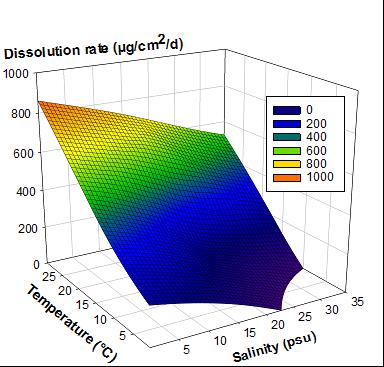 |
| Figure 8: Effect of temperature and salinity on TNT dissolution from explosive solids. Low dissolution rates are observed at low temperature and high salinity, but are not visible here due to plotting artefacts. |
Sink term - Degradation
Degradation of MC determines the extent to which contamination can spread and affect ecological habitats. We conducted a series of incubation experiments to evaluate degradation rates and their dependence on temperature. Whole water MC degradation rates exceeded abiotic rates by a factor of about four, indicating microbial control. Similar to other microbially-mediated reactions, TNT loss rates doubled with every 10°C increase in temperature. The UDEMM numerical model combining these removal rates with dissolution fluxes predicts clear seasonal variation in water column MCs.
|
|
| Figure 14: TNT degradation rates as a function of temperature in whole and microwave-sterilized Baltic Sea water (solid circles and hollow triangles, respectively). The microwave-sterilized treatment reflects abiotic degradation or adsorption onto suspended particles. |
Similar experiments using an axenic monoculture of the hydrocarbon-degrading bacterium A. borkumensis (S. Krause and A. Beck, unpubl.) showed even higher rates of TNT removal, implying that microbial community composition is an important factor in site-specific removal. Indeed, microbial community composition is affected by factors such as salinity, which varies widely in estuarine systems such as the Baltic Sea. More work is necessary to establish if repeated such experimentation is required as a component of monitoring, or if existing data are sufficient to constrain the loss term for predictive modelling.
Metal contamination from munitions sources
Dissolved metals were measured during several cruises at the beginning of the UDEMM project in an attempt to see contamination released from primary explosives (e.g., Pb styphnate or Hg fulminate) or munition housing (e.g., Fe or Zn). However, results showed no elevated enrichment in the vicinity of dense accumulations of munitions (e.g., Pb, Fe), and concentrations were generally within the range expected for the Baltic Sea. As a result, samples for metals analysis were largely discontinued in the second half of the UDEMM period.
Appel, D., Strehse, J. S., Martin, H. J., & Maser, E. (2018). Bioaccumulation of 2, 4, 6-trinitrotoluene (TNT) and its metabolites leaking from corroded munition in transplanted blue mussels (M. edulis). Marine pollution bulletin, 135, 1072-1078.
Beck, A. J., van der Lee, E. M., Eggert, A., Stamer, B., Gledhill, M., Schlosser, C., & Achterberg, E. P. 2019. In situ measurements of explosive compound dissolution fluxes from exposed munition material in the Baltic Sea. Environmental science & technology. 53, 5652−5660.
Böttcher, C., Knobloch, T., Rühl, N.-P., Sternheim, J., Wichert, U. & Wöhler, J. Munitionsbelastung der deutschen Meeresgewässer – Bestandsaufnahme und Empfehlungen (Stand 2011). (2011).
Dontsova, K. M., Yost, S. L., Šimunek, J., Pennington, J. C. & Williford, C. W. Dissolution and Transport of TNT, RDX, and Composition B in Saturated Soil Columns. J. Environ. Qual. 35, 2043–2054 (2006).
Gledhill, M., Beck, A. J., Stamer, B., Schlosser, C. & Achterberg, E. P. Quantification of munition compounds in the marine environment by solid phase extraction – ultra high performance liquid chromatography with detection by electrospray ionisation – mass spectrometry. Talanta 200, 366–372 (2019).
Haas, R. & Thieme, J. Band 2 : Explosivstofflexikon. Bestandsaufnahme von Rüstungsaltlastverdachtsstandorten der Bundesrepublik Deutschland, 2. Erweiterte Auflage, Umweltbundesamt [Inventory suspected armament Contam. sites Fed. Repub. Ger. Second Ext. Ed. Fed. Envi 378 pp. (1996). at <https://www.umweltbundesamt.de/en/publikationen/bestandsaufnahme-von-1>
Lever, J. H., Taylor, S., Perovich, L., Bjella, K. & Packer, B. Dissolution of composition B detonation residuals. Environ. Sci. Technol. 39, 8803–8811 (2005).
Lynch, J. C., Myers, K. F., Brannon, J. M. & Delfino, J. J. Effects of pH and Temperature on the Aqueous Solubility and Dissolution Rate of 2,4,6-Trinitrotoluene (TNT), Hexahydro-1,3,5-trinitro-1,3,5-triazine (RDX), and Octahydro-1,3,5,7-tetranitro-1,3,5,7-tetrazocine (HMX). J. Chem. Eng. Data 46, 1549–1555 (2001).
Monteil-Rivera, F., Deschamps, S., Ampleman, G., Thiboutot, S. & Hawari, J. Dissolution of a new explosive formulation containing TNT and HMX: Comparison with octol. J. Hazard. Mater. 174, 281–288 (2010).
Pichtel, J. (2012): Distribution and Fate of Military Explosives and Propellants in Soil: A Review; Applied and Environmental Soil Science; Volume 2012; 33p.; http://dx.doi.org/10.1155/2012/617236
Sheremata, T. W. et al. Fate of 2,4,6-trinitrotoluene and its metabolites in natural and model soil systems. Environ. Sci. Technol. 33, 4002–4008 (1999)
Strehse, J. S., Appel, D., Geist, C., Martin, H. J. & Maser, E. Biomonitoring of 2,4,6-trinitrotoluene and degradation products in the marine environment with transplanted blue mussels (M. edulis). Toxicology 390, 117–123 (2017).
